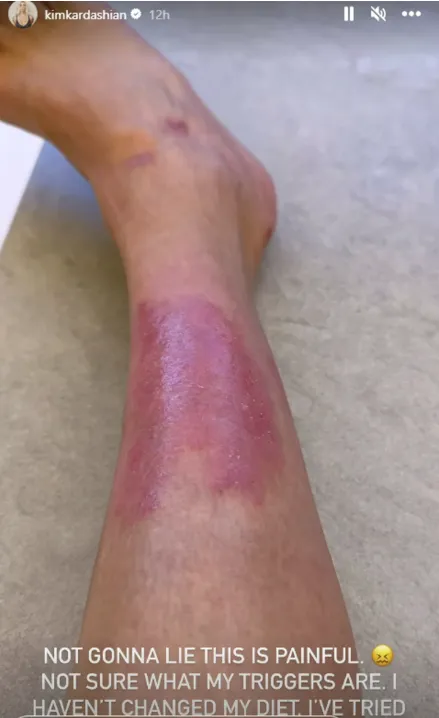
I’ve never been the girl with completely even, not-a-scratch-on-her skin. I scar at the slightest inconvenience, and my legs decided long ago that they love to hold onto hyperpigmentation and discoloration—especially in the summer. I've identified the cause of red spots on my skin (lots of bug bites) and tried the best dark spot correctors as part of my 20-something-year-long mission to figure out how to even skin tone on my legs.
Don't get me wrong: Some unevenness is entirely normal. Birthmarks aren’t going anywhere, and cuts or scrapes will inevitably leave their mark. But a handful of dermatologists recently cued me in on the best hyperpigmentation treatments capable of tackling sun spots, pimple pigmentation, and eczema flares. Remedies span easy at-home options (using a full-body retinol will make a world of difference) to more intensive treatments and lasers available only at the doctor’s office.
Here, board-certified dermatologists Mina Amin M.D., FAAD, Marisa Garshick M.D., FAAD, and Brendan Camp M.D., FAAD, along with Shiela Kassir, plastic surgeon and co-founder of Kassir Plastic Surgery, share their 10 top tips for evening out skin tone on your legs.
What Causes Uneven Skin Tone on the Legs?
The evenness of your skin tone is influenced by a handful of factors, many of which are out of an individual’s control. Genetics, race, and age all play a role and impact how much melanin, aka color, your skin grips onto. “Genetics play a significant role, as they determine your skin type, the amount of melanin produced, and how your skin reacts to various environmental factors. Race also affects skin tone evenness because different skin types have varying levels of melanin, which can influence susceptibility to discoloration,” explains Dr. Kassir, noting that those with darker skin tones are more likely to deal with pigmentation. “Age is another important factor; as you age, your skin can develop uneven pigmentation due to cumulative sun exposure, hormonal changes, and the natural aging process, which can all lead to a less even skin tone.”
That in mind, there are a handful of additional conditions or habits that have the potential to exacerbate uneven tone.

Sun Damage
I always find that my discoloration and melasma is much worse in the summer—and its a fairly common shared experience. “Sun exposure stimulates pigment production as a way to protect skin cells from the damaging effects of UV rays,” explains Dr. Camp. “Photodamage can lead to the formation of sun spots and melasma, although the latter typically affects the face.”
Post-Inflammatory Hyperpigmentation
If you deal with body inflammation—adult-acne, bug bites, shaving marks—it’s safe to say you’ve dealt with post-inflammatory hyperpigmentation, the lingering redness or brown color that remains once the issue has been resolved. “Post-inflammatory hyperpigmentation (PIH) happens when the skin produces excess melanin (color) in response to an injury or inflammation, such as a cut, bug bite, or rash,” Dr. Kassir shares. “This condition is common among people with darker skin tones and can result in dark spots on the legs after the skin has healed.”
Vitiligo
“Vitiligo is a condition where the skin loses its pigment cells (melanocytes), leading to white patches on various parts of the body, including the legs,” explains Dr. Garshick. “The cause of vitiligo is not fully understood, but it is believed to be an autoimmune condition.” It presents as a depigmentation rather than dark spots but can contribute to an uneven skin tone. Some individuals are born with the condition, while others may develop small spots over time.

Melanoma
While uneven tone is usually nothing to worry about, there are cases when spots should cause for concern about skin cancer. “An irregular mole or melanoma can present as a new irregular dark spot on the leg,” explains Dr. Amin. “If a mole is new or changing, see your dermatologist.” To know when something is cause for concern, I’ve always been told to look for the ABCDE warning signs on spots: Asymmetry, Border is irregular, Color, Diameter over six millimeters, Evolving or changing over time. If your spot has one or more of these factors, make an appointment with your doctor for a biopsy.
Eczema or Psoriasis
While eczema and psoriasis are different skin conditions, “both can result in itchy plaques on the skin, which can result in hyperpigmentation as the skin heals,” explains Dr. Amin. While they have distinct clinical features and treatments, both can alter skin tone by causing post-inflammatory hypopigmentation or hyperpigmentation, adds Dr. Camp. Your skin type and tone will influence the intensity of discoloration.

Diabetes
If you’ve been diagnosed with diabetes, you should be under the care of a physician. In addition to managing the condition, however, your doctor should inform you of various skin conditions that can accompany the condition. One is called diabetic dermopathy. “It presents as light brown, scaly patches on the legs,” explains Dr. Kassir. “These patches are usually harmless but can contribute to an uneven skin tone. Poor blood circulation and high blood sugar levels in diabetics can also lead to other skin complications that affect pigmentation.”
How to Even Skin Tone on the Legs
The best way to treat uneven skin tone on the legs is largely determined by what’s causing your discoloration in the first place. Here, dermatologists share some easy tips you can incorporate into your routine or pursue at the doctor’s office. That said, if you suspect your discoloration is due to diabetes or possible melanoma, make sure to consult a board-certified physician as soon as possible.

Wear Sunscreen
If your leg discoloration is from acne, bug bites, scratching, or picking, avoiding sun damage is going to be your best friend—especially in the summer. “It's crucial to protect your skin from sun damage by using a broad-spectrum sunscreen with at least SPF 30, wearing protective clothing, and avoiding peak sun hours,” explains Dr. Garshick. Unprotected exposure to the sun will not only contribute to additional sun spots, but it can also darken existing pigmentation. Make sure you use one of the best body sunscreens before heading out in the sun.
"Offering SPF 60 protection, this fast-absorbing chemical sunscreen can be used on the face and body and contains vitamin E, which has antioxidant properties," says Dr. Camp.
For an SPF that can tackle my face and my body, I reach for this elegant Shiseido formula. It's so lightweight, I forget I'm wearing it. Plus, with a formula that includes antioxidant-packed botanicals, it gives an extra dark spot-fading boost.
Don’t Pick
I’m a picker. I’m the first to admit that when I have a raised bump or knick, my hands are all up there—which is precisely what you’re not supposed to do. “Avoiding picking at scabs, bites, or other skin injuries can reduce the risk of post-inflammatory hyperpigmentation,” explains Dr. Kassir. Dr. Garshick also suggests treating cuts and scrapes promptly by applying Neosporin and a bandage until the wound has healed.
Try Exfoliating Ingredients
Whether your discoloration is caused by dry skin or lingering pigmentation, adding an exfoliating acid—such as salicylic, glycolic, or lactic—into your body skincare routine is worthwhile. “These ingredients break apart dead skin cells to facilitate their removal from the skin surface,” explains Dr. Camp. The sped-up cell turnover will, in turn, lighten dark spots and improve texture over time.
"For someone who prefers a physical exfoliant, this gentle body wash effectively cleanses the skin while gently eliminating dead skin cells, helping to improve overall skin tone and texture. Unlike harsh scrubs, it won’t leave the skin feeling dry or irritated," says Dr. Garshick.
"This is a great option for those with uneven skin, especially on the legs as it gently exfoliates using lactic acid while simultaneously hydrating the skin so it won’t leave the skin feeling dry or irritated," says Dr. Garshick. "It helps to eliminate dead skin cells to leave the skin looking and feeling soft and smooth."
"This re-textures the damaged skin on your body. The gel formula blends hydroxyethyl urea/aminosulfonic acid compound with niacinamide and hyaluronic acid to provide thorough exfoliation coupled with replenishing hydration," explains Dr. Kassir. "It's especially beneficial to dry, rough skin on your elbows, knees, and heels."
Uneven tone and texture sometimes go hand in hand. Deal with both at once with this physical scrub. I keep this stocked in my shower at all time. It's gentle yet effective, with a mix of AHAs, antioxidants, and small physical exfoliants.
Seek Out Antioxidants
There’s no shortage of body serums or the best body lotions out in the skincare world. If evening out the skin tone on your legs is your concern, seek out a product designed to brighten the skin. The best over-the-counter ingredients for the job are vitamin C, vitamin E, and niacinamide.
“Vitamin C is a potent antioxidant that brights the skin and reduces hyperpigmentation,” explains Dr. Kassir, noting that it also protects against free radicals that contribute to dark spots. “Niacinamide, a form of vitamin B3, helps to lighten dark spots and improve skin barrier function, too.”
"Alpha-hydroxy and beta-hydroxy acids are featured in this moisturizing cream that also includes shea butter, jojoba oil and glycerin to brighten and quench dry skin," notes Dr. Camp.
"This body lotion contains peptides, niacinamide, facial-grade oils rich in vitamins A, C, and E, and omega 6 and 9 to hydrate skin, boost firmness, and help even skin tone," says Dr. Camp.
Incorporate Retinol
I’m a huge retinol fan. I’ve been using a prescription cream on my face since I was 12 years old. But I never thought about putting a retinol serum or cream on my legs until Dr. Camp suggested it. “Retinols and retinoids can be used to normalize skin cell turnover, which can help even out skin blemishes,” he explains. It can be a bit drying, so it’s best to look for formulas that are boosted with other hydrating ingredients like ceramides, peptides, and hyaluronic acid. Only use a retinol product at night and make sure to apply sunscreen during the day, as it can make your skin more sensitive.
"This is a game changer for the legs. It evens skin tone and is a must for skin maintenance. The retinol is the youth boosting skincare for your body," explains Dr. Kassir. "The powerhouse ingredient of retinol (Vitamin A derivative) combined with ferulic acid , vitamins C and E, in a silky smooth serum, it helps to rebuild collagen and thicken the skin dermis for tight and firm smooth skin."
With a milky texture and a star lineup of ingredients including retinol, hydrating urea, and a blend of AHAs, this serum-meets moisturizer is loved by reviewers for its ability to target dullness, strawberry legs, and dark spots.
The product I single handedly recommend the most as a beauty editor is Shani Darden's Retinol Reform, which is a facial serum. This is the body counterpart—and rest assured it's just as good. With a powerful retinol and hydrating and soothing ingredients to boot, this will be effective without drying out your skin.
"Remedy is one of my favorites because it has retinol, urea, lactic acid, and ceramides," says Dr. Amin. While it's technically designed for dark spots on the face, you can absolutely use it on your legs, too.
Stay Hydrated
Chances are, you’re already moisturizing post-shower. But if not, let this serve as your reminder. “Keeping your skin moisturized can help maintain its barrier function and prevent conditions like eczema,” explains Dr. Camp. In turn, your skin will be less prone to developing post-inflammatory hyperpigmentation. Check out the best creams for eczema if you need some inspiration.
Opt for a Perscription Cream
If the discoloration on your legs doesn’t want to budge despite continued use of over-the-counter products, your dermatologist might suggest a prescription cream with hydroquinone, a powerful lightening agent that reduces melanin production. “This can help with dark spots on the skin. However, they should be used for three months, then stopped,” explains Dr. Amin. “The cycle is repeated as necessary.” Hydroquinone, when used improperly and long-term, has been shown to affect the liver and kidneys negatively. With that in mind, ensure you’re under a physician’s care and have regular check-ins.
If inflammation, eczema, or psoriasis is the source of your pigmentation, your doctor might prescribe a corticosteroid, essentially a more powerful version of hydrocortisone. “These can reduce inflammation and improve the appearance of dark spots caused by inflammatory conditions,” says Dr. Kassir.
Get a Laser
In-office lasers will cost you a bit of money (you’re looking at a couple thousand when all is said and done), but they can be very efficient at lightening dark spots on the legs. “Laser treatments, such as fractional laser and intense pulsed light (IPL) therapy, target pigmented areas and break down excess melanin,” explains Dr. Kassir. “Fractional lasers create micro-injuries that stimulate collagen production and skin regeneration, leading to a more even tone. IPL uses broad-spectrum light to target pigment and vascular lesions, improving discoloration.”
Lasers are an investment, so make sure you’re talking to your dermatologist or plastic surgeon about every option.
@thevieco ♬ Dance You Outta My Head - Cat Janice
Consider a Chemical Peel
When you think of a chemical peel, you probably envision a facial treatment. But the same fomulas (yes, even at-home chemical peels) can be used on your legs. In fact, you might even be able to tolerate a more intense acid. “Chemical peels involve applying a solution to the skin that causes it to exfoliate and eventually peel off,” explains Dr. Garshick. “This process removes the top layer of damaged skin, revealing fresher, more evenly toned skin underneath.”
Manage Conditions
A large component of treating uneven tone on the legs centers on prevention. If you have vitiligo, diabetes, eczema, or psoriasis, you’ll benefit from swift intervention and professional care. “Managing underlying health conditions like diabetes and seeking prompt treatment for skin conditions like eczema or psoriasis can help maintain an even skin tone,” emphasizes Dr. Kassir. Your doctor will be able to devise a specific treatment plan that will not only treat your condition but also help minimize flares that can lead to dark spots on the legs.
When to See a Doctor About Uneven Tone on Legs
“It is time to see a doctor if OTC treatments are ineffective, if the discoloration worsens, or if there are signs of skin cancer, such as new or changing moles,” explains Dr. Kassir. “Consulting with a medical professional can provide a personalized treatment plan and ensure that any underlying conditions are properly managed.”
You also might consider seeing a doctor if you want birthmarks removed or are considering repigmentation procedures for vitiligo.







